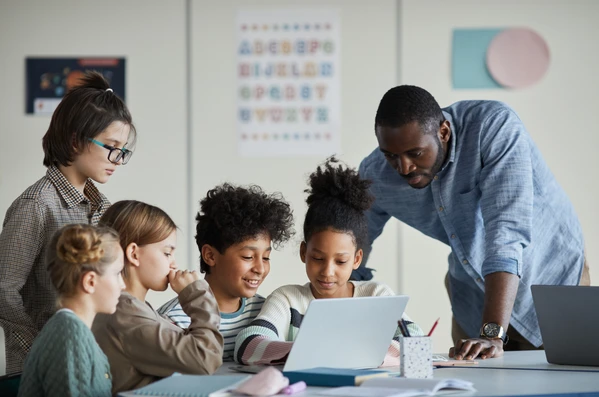Maintaining Heritage Languages To Support the Whole Child
“[If we try] with all our resources to help our learners maintain and develop their first language, the second language, English, will surely come,” Dr. Elena Schmitt, professor and educational researcher, says during this episode of the All For Literacy podcast.
As a bilingual student herself, Dr. Schmitt highlights several key reasons for encouraging multilingual students to continue developing their first language. And with an average of more than 10% of students in public schools as English Learners and with some of the most diverse districts supporting more than 100 languages, it's crucial for educators to understand how to guide multilingual students.
“When we maintain our first language, we maintain not only the morphological and grammatical aspects of that language, but we continue to access the key aspects of cultural and social interaction,” Dr. Schmitt says. For many multilingual learners, their first language is how they connect with parents and grandparents, share traditions, and make sense of the world around them. “[It’s] really important to realize how much the identity of our multilingual learners, of our immigrant students, is intertwined with their ability to communicate in their home language,” Dr. Schmitt says.
Similarly, maintaining and developing a student’s first language actually supports their ability to learn English. The brain doesn’t hit pause between languages; it builds upon what it already knows. Skills in one language—like understanding sentence structure, vocabulary, or storytelling—transfer and strengthen skills in another.
How educators can encourage multilingualism
Actively supporting and encouraging multilingualism in classrooms starts with intentionality. From empowering families to keep using their home language, to building inclusive classroom environments, to thoughtfully applying the science of reading, there are practical, research-backed ways to ensure multilingual learners thrive as they learn a second language.
1. Encourage Families To Keep the First Language Alive
A simple yet powerful way educators can support multilingual learners is by reassuring families that continuing to use their home language is not only welcome but also essential. “Educators need to tell families very straightforwardly that speaking their first language … reading in their first language at home is not only OK, but it is important for the child’s successful overall development and for their acquisition of English,” Dr. Schmitt says.
Well-meaning teachers sometimes encourage families to use English at home, hoping it will accelerate learning. But this can unintentionally limit deep, meaningful connections between children and their caregivers. When families use their strongest language to talk, tell stories, and connect, children develop stronger thinking and language skills and a deeper sense of belonging, all of which support the whole child.
2. Create Inclusive Classrooms That Celebrate All Languages
Teachers have a unique opportunity to create inclusive environments in their classrooms where every language is appreciated. “Within the classroom, educators can also be considerate about using the languages that their students bring into the classroom, even if they’re not familiar with those languages,” Dr. Schmitt says.
From allowing students to speak and write in their home language during certain activities to encouraging them to share books from home, these small choices build a sense of belonging and pride. This inclusive approach—sometimes called translanguaging—recognizes that students naturally draw on all of their language knowledge to communicate and learn.
These approaches not only empower students to bring their full selves into the classroom, but also support their acquisition of English as a second language. “Research shows that reading and writing in the first language and strengthening cognitive and academic skills [transfers] to [learning] the second language,” Dr. Schmitt says.
3. Apply the Science of Reading With Intention
The science of reading offers a strong, evidence-based foundation for literacy instruction, but it’s not one size fits all. “The science of reading provides a very strong foundation for literacy instruction, but we have to be intentional about how we apply it to multilingual learners,” Dr. Schmitt says. Language is just one factor that might impact how the research is applied to each student’s journey; it’s really about pulling the relevant strategies that support that child in particular.
These students are not starting from scratch; they bring with them valuable linguistic knowledge from their first language, which can be leveraged to support their English literacy development. “We have to acknowledge that whatever our multilingual learners do, they build on their existing knowledge of their heritage language … Which is a huge asset if we leverage it correctly,” Dr. Schmitt says.
For example, when reading teachers understand how students’ first languages influence their English acquisition, they can tailor instruction more effectively and empower students to make meaningful connections in both languages. When multilingual learners are learning phonics in English, educators can help students connect what they already know from their first language to English. “Instead of treating phonics as a brand new skill, [the] science of reading could [be applied to] highlight the contrasts between the home language and English and how they overlap and how they differ,” Dr. Schmitt says about cross-linguistic transfer.
Supporting the Whole Child
Supporting a child’s first language isn’t a barrier to learning English, it’s a bridge. With strong partnerships between families and educators, inclusive classrooms that celebrate linguistic diversity, and thoughtful application of the science of reading, students can become confident, capable learners in multiple languages.
Tune into All For Literacy, Season 4, Episode 5, for a deep, research-backed understanding of how helping multilingual students maintain their heritage language supports the whole child.

